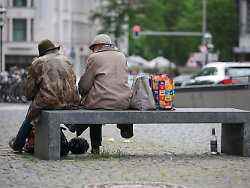Mainly men homeless
178,000 people lack a home of their own
07/15/2022, 00:55
A new survey by the Federal Statistical Office shows the extent of homelessness in this country. At the end of January 2022, 178,000 people were homeless and in appropriate accommodation. But according to the responsible ministries, this is only an excerpt.
In Germany at the end of January this year, around 178,000 homeless people were accommodated in emergency and community accommodation as well as temporary overnight accommodation. The clear majority of them were men at 62 percent, as reported by the Federal Statistical Office in Wiesbaden. The statistics created for the first time are therefore based on reports from municipalities and institutions.
Social Affairs Minister Hubertus Heil stated: “Homelessness has many faces and is not always recognizable at first glance.” How many people are actually homeless and have found shelter on the street or with acquaintances has not yet been recorded in the statistics. Comprehensive total figures are to be provided for the first time by a new survey, as announced by the SPD minister’s ministry in Berlin.
According to figures from the Federal Statistical Office, at the end of January most homeless people lived in Baden-Württemberg and North Rhine-Westphalia, with almost 36,000 people each, followed by Berlin with almost 26,000 people. As of January 31, 2022, the fewest homeless people were housed in Saxony-Anhalt (365 people), Mecklenburg-Western Pomerania (405) and Bremen (790).
On average, those affected were 32 years old on the reporting date. More than a third of them (37 percent) were under the age of 25, and just under 5 percent of those aged 65 and over. Almost 74,000 of the accommodated homeless people were single, a third or almost 59,000 were accommodated within a common household as a family or as a couple with children. Around 23,000 people or 13 percent including the children lived in a single-parent household during the placement.
Extensive report in October
Three percent of those affected were accommodated as couples without children, for the remaining ten percent the household type was “other multi-person household” or the household type was unknown. Almost a third (31 percent) of those affected had German citizenship, 64 percent were foreign citizens. Almost five percent of the people either had no information on their nationality, this was unclear or they were stateless, as the statisticians explained.
The Federal Ministries for Social Affairs and Building announced that with its statistics, the Federal Office is fulfilling a mandate from the Homeless Reporting Act passed in 2020. “However, the group of people affected only represents a selection of all homeless people,” according to the ministries. In addition, an extensive representative survey was commissioned, which provides nationwide reliable figures on homelessness – including homelessness on the streets.
Heil said that with the planned improved database, the welfare state’s focus on the issue of homelessness should also be sharpened. “On this basis, we can develop targeted help to push back the evil of homelessness.
Building Minister Klara Geywitz, also from the SPD, emphasized: “People without a home are often defenseless.” That is why the government is strengthening social housing, for example. A general overview should be given in a homeless report in the autumn. The goal is to “overcome homelessness in Germany by 2030”.
